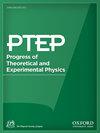规整理论的矩阵正则化
IF 8.3
4区 物理与天体物理
Q1 Physics and Astronomy
引用次数: 0
摘要
我们考虑如何用矩阵模型描述规规理论。传统的矩阵正则化是为标量函数定义的,不适用于轨距场,因为轨距场是纤维束的连接。我们阐明了规规场的自由度与矩阵自由度之间的关系,提出了它们之间的塞伯格-维滕映射(Seiberg-Witten map)。本文章由计算机程序翻译,如有差异,请以英文原文为准。
Matrix regularization for gauge theories
We consider how gauge theories can be described by matrix models. Conventional matrix regularization is defined for scalar functions and is not applicable to gauge fields, which are connections of fiber bundles. We clarify how the degrees of freedom of gauge fields are related to the matrix degrees of freedom, by formulating the Seiberg-Witten map between them.
求助全文
通过发布文献求助,成功后即可免费获取论文全文。
去求助
来源期刊

Progress of Theoretical and Experimental Physics
PHYSICS, MULTIDISCIPLINARY-PHYSICS, PARTICLES & FIELDS
CiteScore
12.00
自引率
5.70%
发文量
148
审稿时长
17 weeks
期刊介绍:
Progress of Theoretical and Experimental Physics (PTEP) is an international journal that publishes articles on theoretical and experimental physics. PTEP is a fully open access, online-only journal published by the Physical Society of Japan.
PTEP is the successor to Progress of Theoretical Physics (PTP), which terminated in December 2012 and merged into PTEP in January 2013.
PTP was founded in 1946 by Hideki Yukawa, the first Japanese Nobel Laureate. PTEP, the successor journal to PTP, has a broader scope than that of PTP covering both theoretical and experimental physics.
PTEP mainly covers areas including particles and fields, nuclear physics, astrophysics and cosmology, beam physics and instrumentation, and general and mathematical physics.
 求助内容:
求助内容: 应助结果提醒方式:
应助结果提醒方式:


